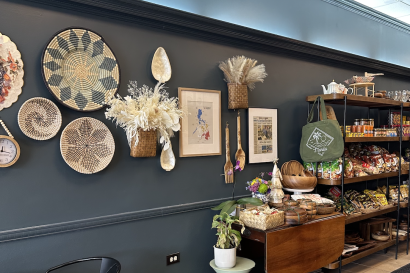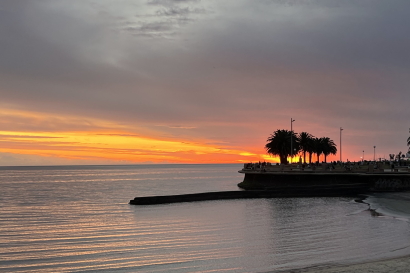Stand here with me in a darkened and infinite, subterranean and concrete room with an automatic door, illuminated by the faces of those who went missing in the '70s and '80s under Pinochet's dictatorship.
9/11.
Every American and Chilean knows this number. In the US, the date signifies when the twin towers fell in 2001. For Chile, it was the day that democracy in the nation died.

Photo of the Moneda in May 2019
On September 11th, 1973, democracy in South America effectively ended. It was a Tuesday. At dawn, advisor Claudio Jimeno phoned president Salvador Allende, urging him to the presidential office, the Moneda, with news that there was a rumor of military general Pinochet stirring a coup. Valparaiso had already been taken under military control. President Allende made an official radio declaration that he would sooner die than give up the Capitol to the terrorists, in what would be his most famous and final speech. Midday, the Chilean Air Force bombed the Moneda, and the army surrounded the building. Historian Peter Winn declared the 1973 coup “one of the most violent events” in all of Chile’s history. As the Moneda was seized, Allende was found in his office, dead by suicide, via the gun gifted to him by Fidel Castro.
Following the attack, thousands of activists, socialists, queer-identifying, and other minority people disappeared and were tortured by the military in secret concentration camps throughout Chile. Today, over 40,000 desaparecidos remain missing in Chile.
At La Museo de la Memoria y Los Derechos Humanos stands a wall spanning over two stories high, filled with pictures of Chile’s desaparecidos, some of the frames still empty to signify those never found. The burned and tattered Chilean independence flag that flew atop the Moneda is encased in glass, underneath a looping video of President Allende’s last speech. Newspapers dated from 9/11 and posters promoting the nonviolent resistance to Pinochet’s dictatorship cover the museum walls.

Two Santiago newspapers dated Sept. 11, 1973

Anti-dictatorship posters
Outside the front entrance to the museum is a staircase leading underneath the plaza. The sign at the top of the staircase reads, “Exhibit open. Inquire with a guide inside.” So I go to the front desk and, with one of the guides, silently descend the staircase. The concrete walls around me resemble a bunker. At the bottom, I see my reflection in the dark glass of the door in front of us. The guide explains that behind the door is an art exhibit by Alfredo Jaar, titled Geometría de la Conciencia, Geometry of Consciousness. It would be completely dark for a few minutes inside, she says. If I need to leave before the exhibit ends, I could press an emergency button. I nod. The door slides open and I walk into darkness.
Up until 1973, socialist President Allende had overseen a relatively peaceful and democratic Chile. Amid the rest of war-torn South America, Chile had held democratic elections since 1932 and had far fewer rates of violent crime. However, farther north, tensions stirred. The U.S.’s Nixon administration was growing nervous about the possible success of the "socialist experiment" in Chile. Newly-declassified CIA statements confirm Nixon’s role in creating the environment for a military junta.

Geometría de la Conciencia
After a painfully extended few minutes in complete black, a wall of lights turns on in front of me. The hairs on my arms stand on end. Dozens of faceless, illuminated silhouettes shine through the darkness. The walls on either side of me are mirrors, extending the pattern of faces to infinity. The lights stay on for a minute, then abruptly shut off again. A reversal of silhouettes blossoms in my eye; the black, faceless portraits are burned into my retina. Nevertheless, as soon as the retina image appears, it starts to fade again, forever lost. This, too, is a statement by Jarr. As I leave the exhibit, the guide hands me a paper upon which this is inscribed:
“Al perderte yo a ti, tú y yo hemos perdido…”
“To lose you, we both have lost…”
- Ernesto Cardenal
Iris del Carmen Acevedo Tobar is your average Chilean abuelita. She visits her children and grandchildren to take care of them. She knits. She’s stoic but says what’s on her mind. Over dinner with my host family, I got her to open up and talk a little and I told her about my visit to the Museo. After some conversation, I discovered that she worked as a secretary in the building directly across from the Moneda when it was bombed that day. After some persuasion, she agreed to a short interview.

Where were you working on September 11, 1973?
“I was working for the Corporation of Agricultural Reform, or CORA, where I was a secretary. The building was located in front of the Moneda. I was on the sixth floor.”
How old were you at the time?
“I was 23.”
Did you side with a political party?
“I wasn’t political; I didn’t understand politics at the time.”
Did you know what was happening when the Moneda was bombed?
“No, I didn’t know what was going on. After [the bombing] happened, my work informed me what had happened and I went straight home.”
What did you do when you got home?
“We waited in our house, my family and I, for five days before going outside. It was then that I finally heard about what happened to the Moneda. I was devastated.”
Is it true that there were torture camps in Santiago under Pinochet?
“Yes, and they looked like regular buildings. From the outside, they appeared normal, but inside them, people were being tortured for information, or for no reason at all.”
Did you know any Desaparecidos?
No comment.
What is the biggest change between Chile after Pinochet compared to when you were younger?
“You could stay out late without being worried about being robbed, not like nowadays. I wore my jewelry in the street, and I wasn’t worried I would be attacked.”
Thank you to Iris del Carmen Acevedo Tobar and her son, Andres Alarcon Acevedo, who assisted with translation.

Rebecca Carey
<p>Rebecca Carey has been an avid literature and science fiction fan since reading her father’s copy of Ron Hubbard’s “Battlefield Earth” as a child. She has been writing professionally for two years and has published prose, poetry, and short fiction in the University of Iowa’s undergraduate literary reviews ‘InkLit,’ ‘Witness,’ and ‘Peripheral’ in 2018 and 2019, and has published poetry translations in the University of Iowa’s undergraduate translation Journal ‘Boundless’ in 2019. She is a Creative Writing and Translation student at the Univerisity of Iowa hoping to pursue a Master’s degree in translation studies after graduation. When she isn’t buried in a book, she’s usually somewhere in between the realm of overthinking, daydreaming, and wishing she was born 500 years in the future so she could have lived on Mars. Favorite novels of hers include Trenton Lee Stwart’s “The Mysterious Benedict Society,” Jeff Vandermeer’s “Annihilation,” and William Burrough’s “Naked Lunch.” Some of her favorite Chilean authors are Lina Meruane, Roberto Balaño, and Pablo Neruda.</p>









